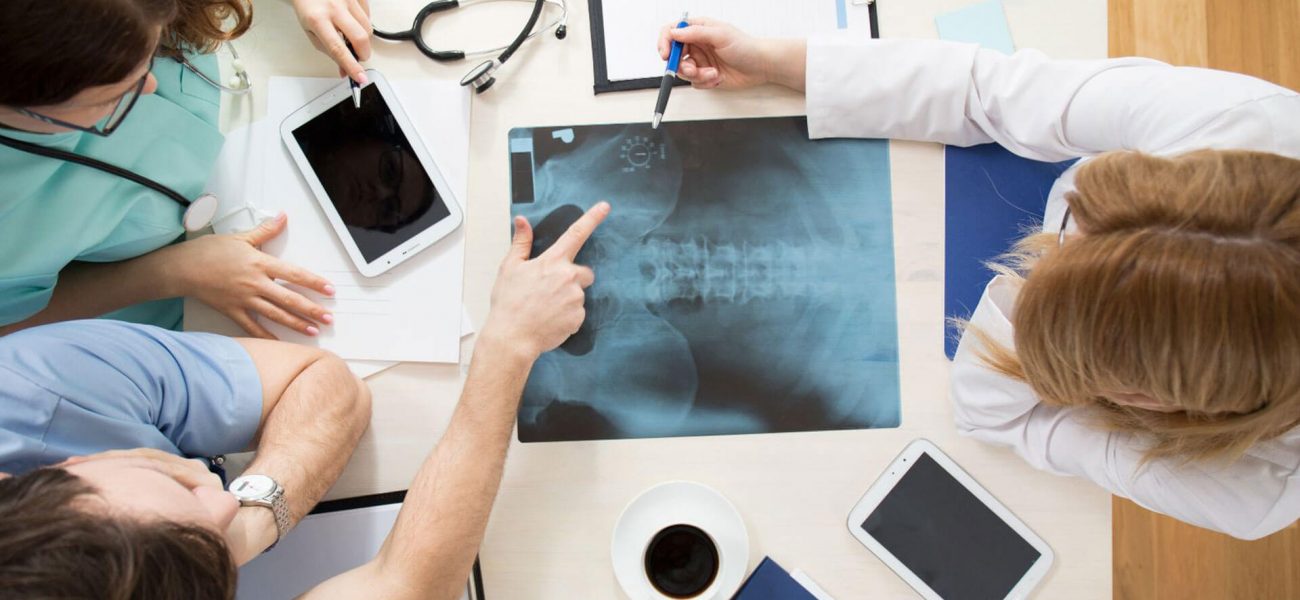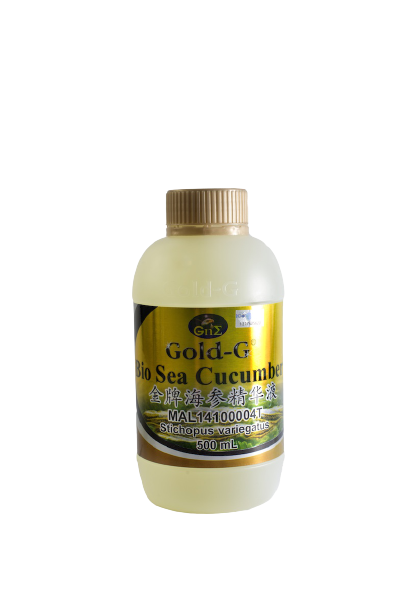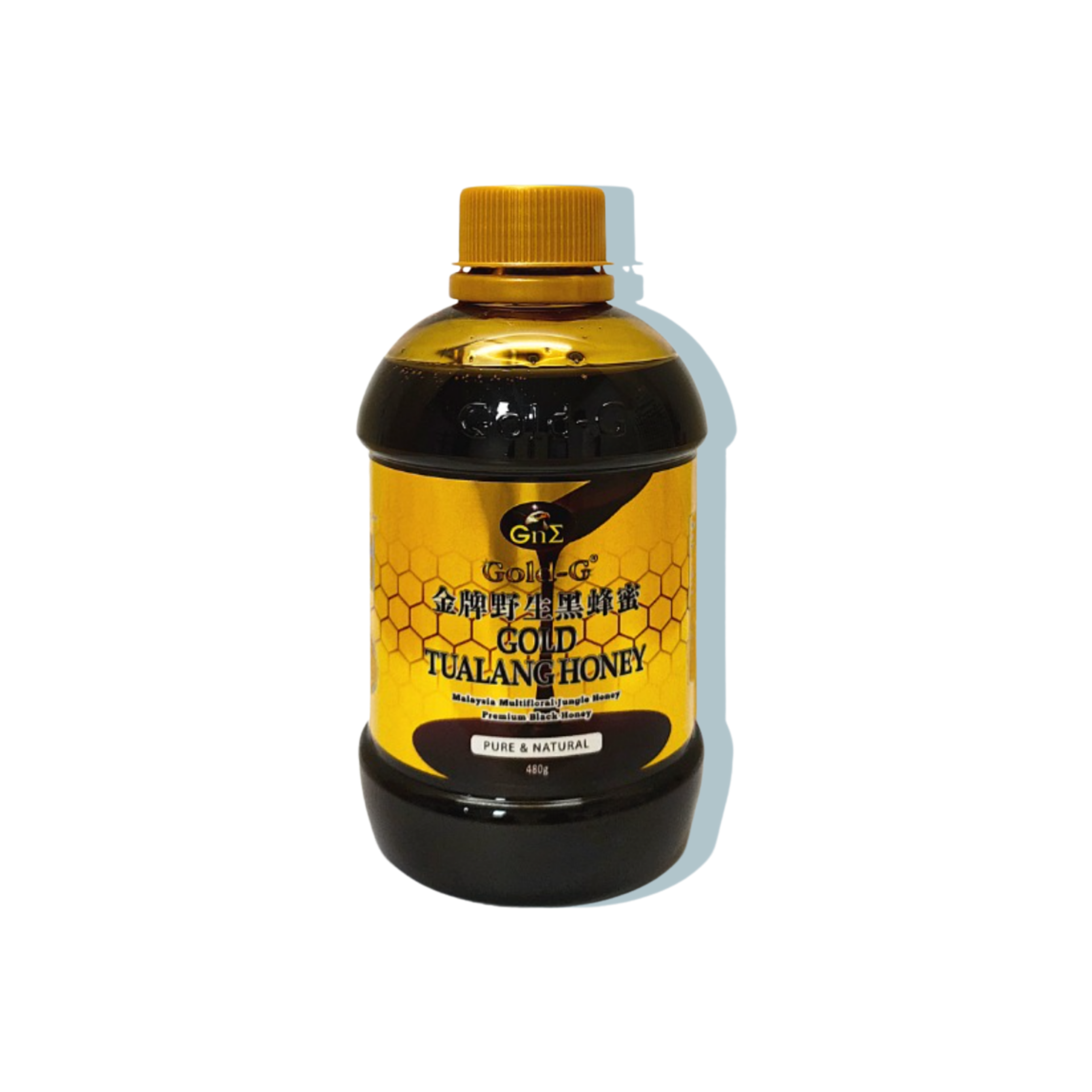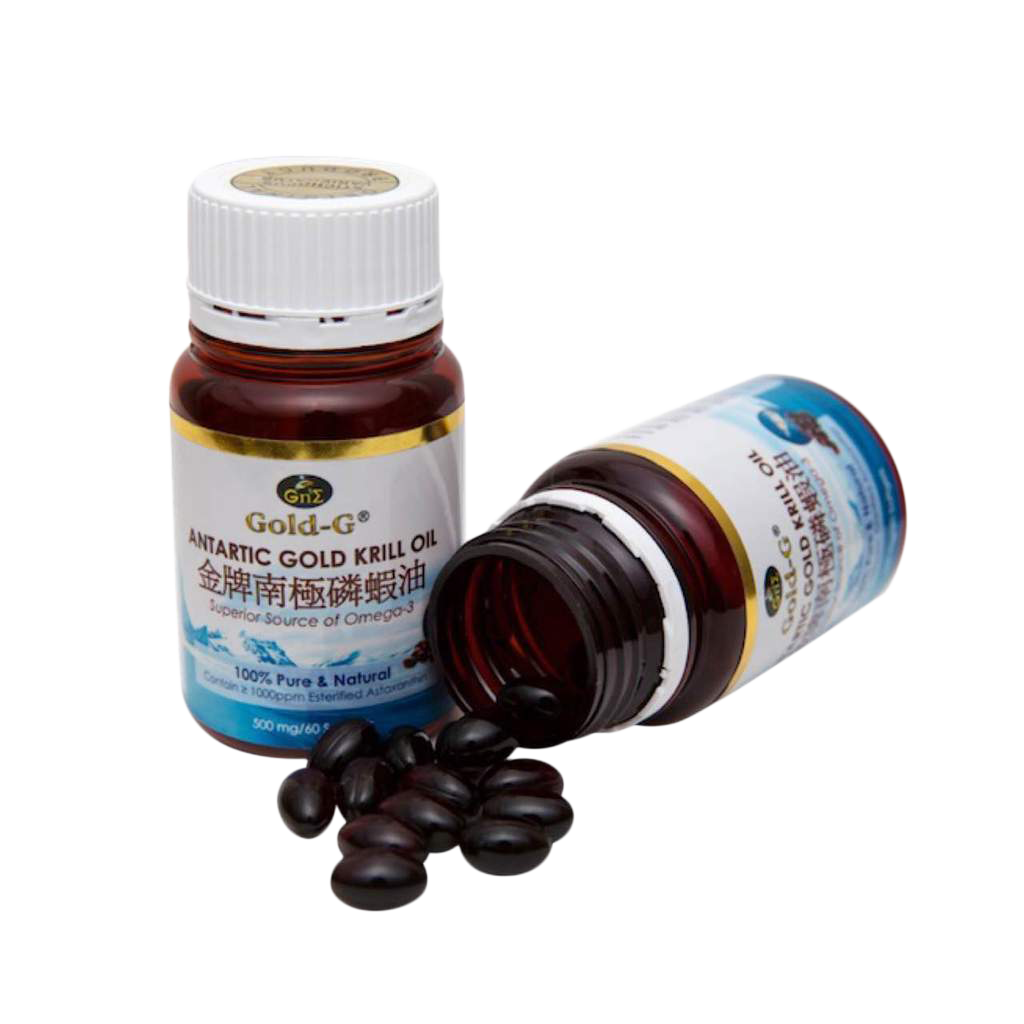Osteoporosis is a chronic metabolic bone disease, which weakens the bone strength and deteriorates the bone structure. Osteoporosis means “the porous bone”, it is a disease that occurs when the bone mass and density are reduced, causing the bone to become porous, fragile, and break easily. Osteoporosis is also known as a “silent disease”, whereby people normally do not observe any signs and symptoms until the condition worsens and affected their daily life.
Osteoporosis is a common disease among older people and post-menopausal women, which is known to be caused by natural aging or insufficient vitamin D and calcium intake. However, frequent falling, injury, and other factors can increase the risk of osteoporosis too.
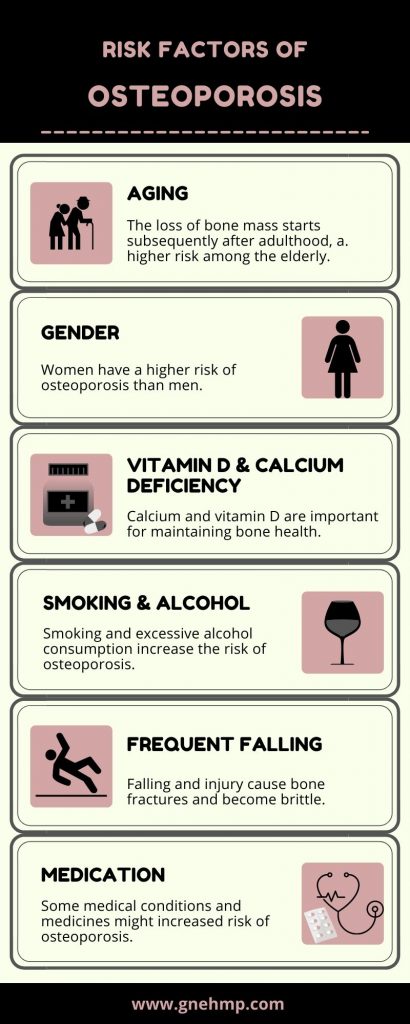
Risk factors
1. Aging. Aging increases the risk of osteoporosis as the loss of bone mass starts subsequently after adulthood, while higher risk among the elderly. Aging lower down the bone formation rate, while bone loss rate is higher due to the body metabolism which reabsorbed old bone cells and builds new bone cells. When a new bone cell formation rate is lower than the bone loss rate, the risk of fracture bone will increase.
2. Gender. Women have a higher risk of osteoporosis than men. The bone loss more rapidly and bone formation rate lower in women after menopause due to estrogen deficiency. Estrogen is a female hormone which can help to decrease bone loss rate by suppressing the activity of osteoclast which reabsorbs old bone cell and inducing osteoclast death.
3. Vitamin D deficiency and low calcium intake. Calcium and vitamin D are important for maintaining bone health, where calcium is the major component of bone and skeleton, while vitamin D helps to enhance the absorption of calcium and maintain serum calcium level in the body.
4. Smoking and excessive alcohol consumption. Smoking is known to be the risk factor of various diseases, which also increase the risk of osteoporosis and affect bone healing after fracture; While excessive alcohol consumption interferes with the balance of calcium in the body and may lead to more falls and fracture.
5. Frequent falling. Falling and injury are the common causes of bone fractures, but these might not be the main causes of osteoporosis. The falling among youngsters might have no or less impact on the bone health while falling among the elderly can lead to life threatening conditions. This is because the bone formation rate is lower than the bone loss rate, while fractures increase the loss of bone cells, cause the bone to become brittle and increase the risk of osteoporosis.
6. Medicines and medical conditions. Some diseases, medical conditions, and medicines may be associated with an increased risk of osteoporosis. For example, rheumatoid arthritis is one of the diseases that may increase the risk of fracture and osteoporosis; while the use of glucocorticoids for more than 3 months or prolonged use of psychoactive medications that causing sedation might induce osteoporosis.
Diagnosis
Since osteoporosis is a silent disease which has no sign and symptoms, diagnosis is important for earlier detection and prevention. There are a few techniques for the diagnosis of osteoporosis:
- Measurement of bone mineral density (BMD)
- Dual-Energy X-ray Absorptiometry (DXA)
- Fracture Risk Assessment Tool Model (FRAX)
- Vertebral Imaging (Vertebra Fracture Assessment)
- Biochemical Bone Turnover Marker (BTM)
Prevention and management
1. Consume a healthy diet, increase calcium and vitamin D. A well-balanced diet is important for maintaining body health and providing nutrients to prevent deficiency. Adequate calcium and vitamin D intake may help to maintain bone density and allow efficient bone formation.
The National Osteoporosis Foundation recommended the calcium intake of 1200mg/day from diet and supplement to all age groups, and vitamin D intake of 800 – 1000 IU/day especially for adults more than 50 years old.
The risk of osteoporosis could be reduced by consuming food rich in calcium such as low-fat dairy products, dark green leafy vegetables, soybean, almond, fortified grains and cereals; and food rich in vitamin D, including egg yolk, fatty fish such as salmon, mackerel, and tuna, fortified dairy products, and fortified cereals. Besides, exposure to sunlight without applying sunblock for 5 to 30 minutes can help the body to gain vitamin D too.
2. Exercises. Exercises are one of the ways to strengthen muscle and bone health. Weight-bearing and muscle-strengthening exercises are the recommended exercises for osteoporosis prevention since these exercises can improve agility, posture, balance, and strength to prevent falls. The examples for weight-bearing exercises included walking, jogging, hiking, and climbing stairs; while muscle-strengthening exercises included lunge, push-up, plank, etc.
3. Avoid excessive alcohol consumption. As excessive alcohol consumption may interfere with the balance of calcium in the body, limit and reduce alcohol consumption might be helpful. For recommended alcohol consumption, men should not consume more than 2 drinks per day, while women should not consume more than 1 drink per day. The portion size of a drink is 12 oz (355ml) of beer, or 4 oz (118ml) of wine, or 1.5 oz (44ml) of 80-proof spirits.
4. Quit smoking. Quit smoking may be a great solution for overall health maintenance. Smoking cessation products, therapy and programs may help smokers to quit smoking more efficiently. Using the over the counter (OTC) smoking cessation products such as skin patches, lozenges, and prescription medicines might be helpful, but it is better to have a consultation with doctor or health care provider before using these products.
5. Regular health check. Health check helps to evaluate and examine the body health status and is an important step for disease prevention and treatment as it helps to identify early signs of health problems. It may not be necessary to have health check every year, you can ask your doctor or health consultant how often you should have a health check and the tests recommended according to your situation.
6. Health supplements and natural products. Besides calcium and vitamin D, there are other nutrients and foods which can improve bone health and reduce the risk of osteoporosis.
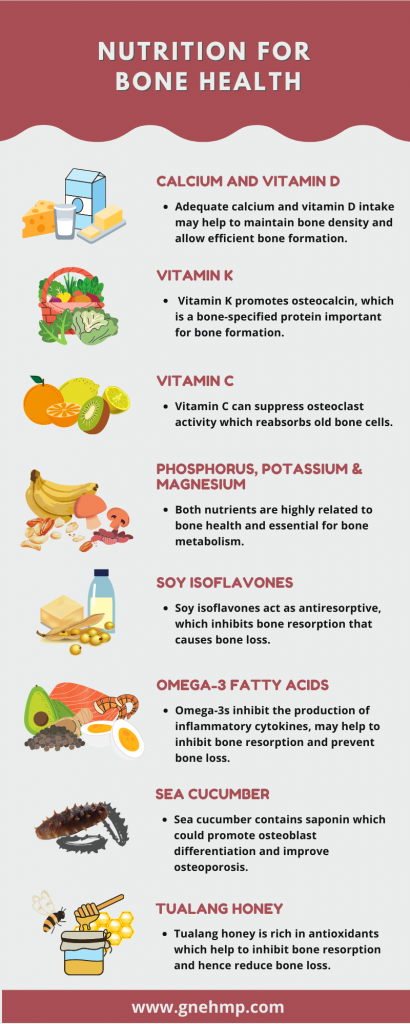
- Calcium and Vitamin D. Calcium and vitamin D are important for maintaining bone health, where calcium is the major component of bone and skeleton, while vitamin D helps to enhance the absorption of calcium and maintain serum calcium level in the body.
- Vitamin K. Vitamin K is an important nutrient for bone metabolism. Vitamin K promotes osteocalcin, which is a bone-specified protein produced by osteoblast and important for bone formation. Inadequate vitamin K intake will increase the risk of age-related bone loss and fracture. Vitamin K can be obtained through the consumption of vitamin K rich food, such as dark green leafy vegetables (kale, mustard green, spinach), natto, beef liver, prune, cheese, etc.
- Vitamin C. Consumption of vitamin C is helpful to reduce osteoporosis as vitamin C can suppress osteoclast activity which reabsorbs old bone cells. Besides, vitamin C is also a cofactor which promotes osteoblast activity that builds the new bone cells, and cofactor for collagen formation. Besides vitamin C supplements, frequent consumption of foods rich in vitamin C may be beneficial. Food rich in vitamin C included black current, kiwifruit, guava, orange, strawberries, etc.
- Phosphorus, potassium, and magnesium. Both nutrients are highly related to bone health, whereby phosphorus is essential for bone mineralization and osteoblast function; potassium may alter the calcium retention in the kidney; magnesium is essential in calcium metabolism. Both can be found in fruits and vegetables.
- Soy isoflavones. Soy isoflavones are the major phytoestrogens contained in soybean or soy-based products. Soy isoflavones act as antiresorptive, which inhibits bone resorption that causes bone loss. Besides, soy isoflavones also stimulate bone formation by increasing serum osteocalcin concentration and promote calcium absorption while inhibiting calcium loss from bone.
- Omega-3 fatty acids. Omega-3 fatty acids are long-chain polyunsaturated fatty acids that are beneficial for bone health. Omega-3s can inhibit the production of inflammatory cytokines which stimulate osteoclast activity, hence may help to inhibit bone resorption and prevent bone loss. Omega-3s can be obtained through the consumption of foods such as fatty fish, egg, shrimps, oysters, walnuts, chia seeds, soybean, and avocado.
- Sea cucumber. Sea cucumber contains saponin which could promote osteoblast differentiation and improve osteoporosis. Besides, sea cucumber contains pharmaceutical components that could maintain bone health, hence it is beneficial for the treatment to bone loss diseases such as osteoporosis.
- Tualang honey. Tualang honey is rich in antioxidants, such as flavonoids and phenolic acids. These compounds provide antioxidative and anti-inflammatory properties, which help to inhibit bone resorption and hence reduce bone loss and increase bone density.
Gold-G® Bio Sea Cucumber
Gold-G® Bio Sea Cucumber is a traditional health supplement containing high concentration of sea cucumber extract which is rich in several pharmaceutical components that are could help to repair and maintain healthy bone and joint, such as saponin, collagen, glucosamine, chondroitin sulfate, and mucopolysaccharide.
- Saponin promotes osteoblast differentiation and improves osteoporosis.
- Collagen can strengthen tendon and ligament, improve bone and joint health.
- Glucosamine and chondroitin sulfate able to reduce arthritis pain, strengthen cartilage, tendon & ligament health, and suppress inflammation.
- Mucopolysaccharide can improve wound contraction and accelerate wound healing.
Gold-G® Gold Tualang Honey
Tualang honey is raw honey harvested from Malaysia’s tropical rainforest. It is 100% pure and natural without undergo any additional treatment, hence it retained natural friendly bacteria, propolis, pollen grains, phytonutrients, phenolic acids, and flavonoids. Besides natural taste and aroma, Tualang honey has higher nutritional value and stronger therapeutic effects than processed honey!
- The antioxidants, flavonoids and phenolic acids provide antioxidative and anti-inflammatory properties, which help to inhibit bone resorption and hence reduce bone loss and increase bone density.
Gold-G® Antarctic Gold Krill Oil
Krill oil is an increasingly important source of omega-3 fatty acids specific for DHA and EPA. The fatty acids in krill oil are found in the form of phospholipid, which provides better bioavailability in terms of absorption and effectiveness. Besides, krill oil also contained a natural antioxidant, astaxanthin that could protect against oxidation and provide several health benefits.
- Krill oil contains omega-3 fatty acids such as EPA & DHA that are beneficial for bone health. Omega-3 fatty acid is a long-chain polyunsaturated fatty acids (LCPUFA) that could affect osteoclast formation and reduce bone resorption.
Click the link below for direct purchase.
References:
- Chye S.M., Tai S.K., Koh R.Y., Ng K.Y., (2017). A Mini Review on Medicinal Effects of Edible Bird’s Nest. Letters in Health and Biological Sciences. Available at: https://www.ommegaonline.org/article-details/A-Mini-Review-on-Medicinal-Effects-of-Edible-Birds-Nest/1499
- FDA, (2017). Want to Quit Smoking? FDA Approved Product Can Help [online]. Available at: https://www.fda.gov/consumers/consumer-updates/want-quit-smoking-fda-approved-products-can-help
- Kling J.M., Clarke B.L., & Sandhu N.P., (2014). Osteoporosis Prevention, Screening, and Treatment: a review. Journal of Women’s Health. 23(7), pp 563–572. Available at: https://www.ncbi.nlm.nih.gov/pmc/articles/PMC4089021/
- Li, Z., Tian, Y., Ma, H., Wang, M., Yan, Z., Xue, C., & Wang, J. (2020). Saponins from the sea cucumber promotes the osteoblast differentiation in MC3T3-E1 cells through activation of BMP2/Smads pathway. Current pharmaceutical biotechnology, 10.2174/1389201021666200519135446. Advance online publication. https://doi.org/10.2174/1389201021666200519135446
- Mohd Effendy N., Mohamed N., Muhammad N., Mohamad I. N., & Shuid A. N. (2012). The Effects of Tualang Honey on Bone Metabolism of Postmenopausal Women. Evidence-based complementary and alternative medicine. 2012, 938574. Available at: https://www.ncbi.nlm.nih.gov/pmc/articles/PMC3437962/
- NIH, (2018). Smoking and Bone Health [online]. NIH Osteoporosis and Related Bone Diseases ~ National Resource Center. Available at: https://www.bones.nih.gov/health-info/bone/osteoporosis/conditions-behaviors/bone-smoking
- Prentice A., (2004). Diet, nutrition and the prevention of osteoporosis. Public Health Nutrition. 7(1A), pp 227 – 243. Available at: https://www.who.int/nutrition/pu blications/public_health_nut8.pdf
- Sahni S., Mangano K.M., McLean R.R., Hannan M.T., & Kiel D.P., (2015). Dietary Approaches for Bone Health: Lessons from the Framingham Osteoporosis Study. Current Osteoporosis Reports. 13(4), pp 245–255. Available at: https://www.ncbi.nlm.nih.gov/pmc/articles/PMC4928581/
- Sözen T., Özışık L., & Başaran N.Ç. (2017). An overview and management of osteoporosis. European Journal of Rheumatology. 4(1), pp 46–56. Available at: https://www.ncbi.nlm.nih.gov/pmc/articles/PMC5335887/
- Zheng X., Lee S.K., & Chun O.K., (2016). Soy Isoflavones and Osteoporotic Bone Loss: A Review with an Emphasis on Modulation of Bone Remodeling. Journal of Medicinal Food. 19(1), pp 1–14. Available at: https://www.ncbi.nlm.nih.gov/pmc/articles/PMC4717511/
This website does not provide medical advice. The content of this website, such as graphics, images, text and all other materials, is provided for reference and educational purposes only. The content is not meant to be complete or exhaustive or to apply to any specific individual’s medical condition. Always seek the advice of your doctor or other qualified health provider regarding a medical condition.

